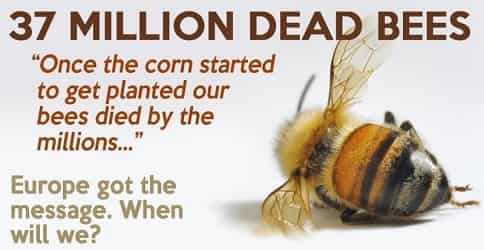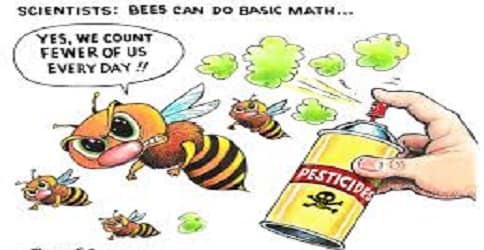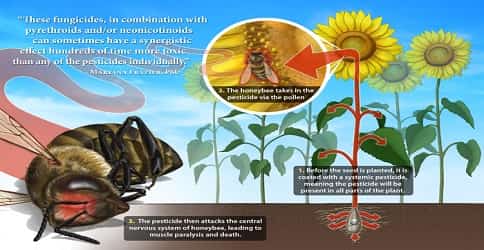
Insecticides kill insects
It should be no surprise, then, that in Brazil, which has seen a 27% increase in pesticide sales since last year, roughly 500 million honey bees were found dead in piles across four states in early spring. The country’s pesticide use has grown by 770% between 1990 to 2016, as reported by Bloomberg.
Insecticides like sulfoxaflor and neonicotinoids have been shown to harm bees, impairing their reproductive health and even killing them outright. Combined, these stresses contribute to an event known as a colony collapse, where many thousands of bees suddenly die. The cause of these mysterious deaths eluded entomologists for a decade; now, study after study has pinned them on the chemicals.
In the US, beekeepers are fully aware of the struggles facing their industry. A 2019 report found that four in 10 colonies were lost in the worst winter for US honey beekeepers ever recorded. It’s clear that if insecticides continue to be used freely, insects like honey bees will continue to die.
Why It’s Happening
There have been many theories about the cause of CCD, but the researchers who are leading the effort to find out why are now focused on these factors:
- Increased losses due to the invasive varroa mite (a pest of honey bees).
- New or emerging diseases such as Israeli Acute Paralysis virus and the gut parasite Nosema.
- Pesticide poisoning through exposure to pesticides applied to crops or for in-hive insect or mite control.
- Stress bees experience due to management practices such as transportation to multiple locations across the country for providing pollination services.
- Changes to the habitat where bees forage.
- Inadequate forage/poor nutrition.
- Potential immune-suppressing stress on bees caused by one or a combination of factors identified above.

A new study has found traces of neonicotinoid chemicals in 75% of honey samples from across the world.
The scientists say that the levels of the widely used pesticide are far below the maximum permitted levels in food for humans. In one-third of the honey, the amount of the chemical found was enough to be detrimental to bees. Industry sources, though, dismissed the research, saying the study was too small to draw concrete conclusions. Neonicotinoids are considered to be the world’s most widely used class of insecticides.
Bad news for the queens
A lack of hygiene wasn’t the worst of it. The tainted hives tended to lose their queen and then struggled to find a new one. A queen sustains the colony, so without her, there are no eggs or future bees.
Remember those other chemicals — the herbicides and fungicides — the Canadian study found in the fields? Other labs had shown that fungicides make neonicotinoids more toxic, so Zayad’s team tested them, too. Neither the most common herbicide (linuron) nor the most common fungicide (boscalid) affected worker bee mortality on their own. But when the bees were exposed to the fungicide in combination with the neonicotinoid clothianidin, it took half as much of the chemicals to kill as many bees. The same applied if clothianidin was swapped with another neonicotinoid, thiamethoxam.
Preventing Pesticide Kills

Many pesticides are extremely toxic to honey bees and other beneficial insects. Honey bees are attracted to blooming flowers of all types. If at all possible do not spray blooms directly with pesticides. If the bloom needs to be sprayed, apply the pesticides in the evening hours. Honey bees forage during daylight hours when the temperatures are above 55-60°F. As the sun begins to set, they return to their hives for the evening. Thus, spraying pesticides in the evening hours can greatly reduce honey bee mortality because the bees are not in the fields.
Recovery from Pesticide Exposure
Colonies that have been exposed to pesticides may recover if proper steps are taken. If a colony has lost a majority of its field force but has plenty of honey and pollen it will usually recover without any help from the beekeeper.
If brood and nurse bees continue dying, the pesticide is present in the hive, probably in the pollen supplies. The colony will continue to die as long as the poison remains in the hive. In these cases the combs must be cleaned or removed. Soak the combs in water for 24 hours. Then wash the pollen from the cells and allow the combs to dry. Another method is to remove the wax comb and replace it with new foundation.
- Magnetic storms: the sun is testing the planet🌪️ - 13.06.2024
- Why You Should Drink Chicory: Benefits and Harms 🌿 - 09.06.2024
- Innovative Choice: Sproud Milk – Your Ideal Plant-Based Drink 🌱 - 03.06.2024


